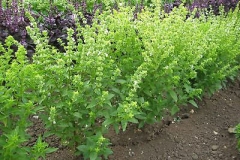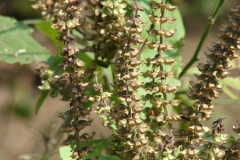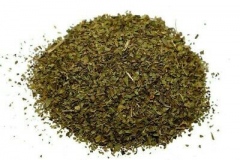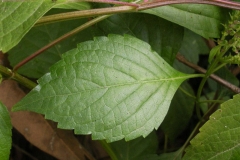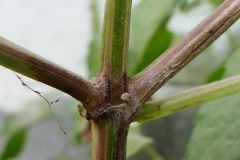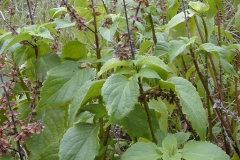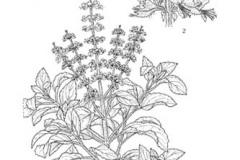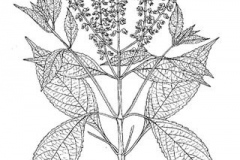| African basil Quick Facts | |
|---|---|
| Name: | African basil |
| Scientific Name: | Ocimum gratissimum |
| Origin | Tropical Africa, Madagascar, India, South East Asia and the Bismarck Archipelago |
| Colors | Brown |
| Shapes | Nutlets sub-globose, 1.5-2 mm in diameter, slightly rugose |
| Health benefits | Maintain eye health, Helps digestion, Lowers blood sugar, Reduces inflammation, Improves heart health, Treats fungal infections, Treats Diarrhea, Treatment of respiratory disorders, Heals Wound, Promotes oral hygiene, Anti-mutagenic properties, Promotes hair growth, Reproductive health, Cough and Sore throat, Manages seizures and convulsions, Cures Fever and Malaria |
| Name | African Basil |
|---|---|
| Scientific Name | Ocimum gratissimum |
| Native | Tropical Africa, Madagascar, India, South East Asia and the Bismarck Archipelago. It is cultivated and naturalized in China, South America, the Caribbean, Australia, New Zealand, Polynesia, Hawaii, Mexico, Panama, West Indies, Brazil, Bolivia and on many islands in the Indian and the Pacific region. It is considered invasive on a number of Pacific and Caribbean Islands |
| Common Names | African basil, clove basil, shrubby basil, tree basil, wild basil, East Indian basil, Nchanwu leaf, Russian basil, African tea bush, Camphor basil, Clocimum, Mary bush, Caribbean basil, Pale-yellow-flowered basil, South-East Asian tree basil, clover basil, fever plant, mosquito plant wild basil, Zulu basil, lemon basil, tea bush |
| Name in Other Languages | Amharic: Anich’eba (ኣንጨባ) Arabic: Furanjmishk, habiq bahij (حبق بهيج) Assamese: Ram tulsi (ৰাম তুলসী), Gandha-tulasi Azerbaijani: Gözəl reyhan Bengali: Ramtulsi, Ramtulshi (ৰাম তুলসী) Brazil: Alfavaca brava Cambodia: Ling leak kranam Chinese: Ding xiang luo le (丁香罗勒), wu mao ding xiang luo le, Yìndù líng líng xiāng (印度零陵香), Měi luólè (美羅勒) Cuba: Albahaca de clavo, canela, clavo, clavo mondonguero, laurel cimarrón, orégano cimarrón Dominican Republic: Albahaca vaca, atiyayo Dutch: Boombasilicum English: African basil, Caribbean basil, Clove basil, East Indian basil, Pale-yellow-flowered basil, Russian basil, Shrubby basil, South-East Asian tree basil, Tree basil, clover basil, fever plant, mosquito plant wild basil, Zulu basil, lemon basil, tea bush Finnish: Pensasbasilika French: Basilic à fleurs jaune-verdâtre-pâle, Basilic africain, Basilic à thymol, Basilic en arbre, Basilic de Ceylan, Basilic de Nouvelle Guinée, Basilic mentholé, Basilic suave, Baumier, Grand framboisin, Menthe gabonaise, Thé de Gambie, basilic, basilic sauvage, basilic-arbre, faux basilic German: Baum-Basilikum, Ostindisches baumbasilikum, Tree-Basilienkraut, afrikanisches Basilikum Gujarati: Avachibavachi, Ramtulasi Haiti: Basilic à petites fleurs, basilic grandes feuilles, folle basin, fombasin, gran basilique, grand basilique, grand fombasin Hindi: Bantulsi, Malatulsi, Raam tulasii, ajeka, doshakleshi, elumiccam tulaci, elumichanthulasi, kattuthrithavu, mali-thulasi, perumthulasi, Ram tulsi (राम तुलसी), Ban tulsi (बन तुलसी) Indonesia: Kemangi hutan, ruku-ruku rimba, selaseh mekah Italian: Basilico cespuglioso Jamaica: African tea bush Japanese: Indo mebouki (インドメボウキ) Lesser Antilles: Basilic, frond bazin, mint Malay: Kemangi, Sulasih miyik, Ruku-ruku hitam, Ruku-ruku rimba Malayalam: Kattutrittavu, Ramtulasi, kattu thulasi (കാട്ടുതുളസി), Karpoorathulasi, Kattuthrithavu, Attuthulasi, Anathuasi, Ramathulasi Malaysia: Ruku-ruku hitam, selaseh besar Manipuri: Ram tulsi (ৰাম তুলসী) Maori (Cook Islands): Miri nganga‘ere, miri papa‘ā, miri tītā, miri tūpāpaku, miri tūtae puaka, miri taratoni Marathi: Ajavala (अजवला), ramatulasi (राम तुलसी), tanatulasu, Nepali: Ram Tulasii, Van tulasii Netherlands Antilles: Anis, yerba di hole blanku Nigeria: Nchuanwu/ Ahuji, efirin, daidoya Oriya: Sondabhogohulono Panama: Origanum de castilla Persian: اسیموم گراتیسیموم Polish: Bazylia eugenolowa Portuguese: Alfavaca, Alfavaca-de-caboclo, Louro, Louro-cheiroso, alfavacã, alfavaca-cravo , alfavacão, manjericão-cheirosa, manjericão-indiano, Alfavaca brava Russian: Bazilik evgenol’nyy (Базилик эвгенольный) Sanskrit: Ramatulsi, Sukshmaputraka, Vanabarbarika, Van tulsa, Vriddhatulasi, ajaka, ajeka, bilvaparni, doshakleshi, Bilvaparni Sinhalese: Tankay Spanish: Clavo canela, Orégano cimarrón, Albahaca cimarrona, Albahaca de clavo, Albahaca montés, Albahaca del monte, Albahaca gratísima, Clavo canela, Orégano cimarrón, albahaca Africana, albahaca cimarrona, albahaca de limón Swedish: Nejlikbasilika , ostindisk basilica, trädbasilika Tagalog: Balanoi Tahitian: Miri papa‘ā, miri taratoni Tamil: Elumicha tulasi, Peruntulasi, elumiccam tulaci, Karuntuḷaci (பெருந்துளசி) Telugu: Nimmatulasi, Ramatulsi (రామ తులసి) Thai: Bı r̂ā (ใบร้า), Horapha chang, Ka phrao yuan, Niam, kaphrao-chang, yira, Kapherā khwāy (กะเพราควาย) Urdu: Tukhm faranjmushk Vietnamese: E lá lớn, hương nhu trắng Yoruba: Efinrin |
| Plant Growth Habit | Aromatic, perennial plant |
| Growing Climates | Roadsides, wasteland, coastal scrubland, lakeshores, savannas, sub-montane forest, disturbed areas around villages and along roadsides and streams, moist and dry deciduous forests, plains, valleys, pastures, waste areas, and riparian areas |
| Soil | Prefers moist and fertile soils during growth, but will tolerate drought after flowering |
| Plant Size | About 1-3 m tall |
| Stem | Erect, round-quadrangular, much branched, glabrous or pubescent, woody at the base, often with epidermis peeling in strips |
| Leaf | Opposite, broadly to narrowly ovate, usually 5-13 cm long and 3-9 cm wide, both surfaces copiously glandular punctate, upper surface is glabrate to sparsely puberulent while lower surface is puberulent on veins |
| Flower | Greenish white to greenish yellow, 4-7 mm long. Sepal cup is 3-5 mm long, enlarging up to 7 mm long in fruit. |
| Fruit Shape & Size | Nutlets subglobose, rugose, brown, smooth with a glandular depression, not mucilaginous when wetted |
| Fruit Color | Brown |
| Seed | Relatively small, numerous and enclosed in nutlets |
| Propagation | By seed or cuttings |
| Flavor/Aroma | Sweet scent of camphor |
| Health Benefits |
|
Plant Description
African basil is an aromatic, perennial plant that normally grows about 1-3 m tall. The plant is found growing in roadsides, wasteland, coastal scrubland, lakeshores, savannas, sub-montane forest, disturbed areas around villages and along roadsides and streams, moist and dry deciduous forests, plains, valleys, pastures, waste areas, and riparian areas. Normally the plant prefers moist and fertile soils during growth, but will tolerate drought after flowering. Stems are erect, round-quadrangular, much branched, glabrous or pubescent, woody at the base, often with epidermis peeling in strips. Its characteristic pleasant aroma is credited to its volatile oil content.
Leaves
Leaves are opposite, broadly to narrowly ovate, usually 5-13 cm long and 3-9 cm wide, both surfaces copiously glandular punctate, upper surface is glabrate to sparsely puberulent while lower surface is puberulent on veins. Margins are serrate, apex acuminate, base cuneate while petioles are 1-6 cm long.
Flower
Inflorescence is arranged in a terminal, simple or branched raceme 5-30 cm long. Rachis is lax and softly pubescent. Bracts are sessile, ovate, 3-12 mm long and 1-7 mm wide, acuminate. Pedicel is 1-4 mm long, spreading or ascending, slightly curved; flowers in 6-10-flowered verticillasters, small, hermaphrodite. Calyx is 2-lipped, 2-3 mm long, in fruit 5-6 mm, pubescent, upper lip rounded and recurved, reflexed in fruit, lower lip with 4, narrow, pointed teeth, and central pair of teeth minute and much shorter than the upper lip. Corolla is campanulate, 3.5-5 mm long, 2-lipped, greenish white to greenish yellow, pubescent outside, upper lip truncate, 4-fid, lower lip longer, declinate, flat and entire. Stamens 4, declinate, in 2 pairs, inserted on the corolla tube, filaments distinctly exserted, upper pair with a bearded tooth at the base; ovary superior, consisting of 2 carpels, each 2-celled, style 2-fid.
Fruits
Fertile flowers are followed by 4, dry, 1-seeded nutlets enclosed in the persistent calyx (the lower lip closing the mouth of the fruiting calyx). Nutlet is sub-globose, 1.5 mm long, rugose and brown. Outer pericarp is not becoming mucilaginous in water.
Seeds are relatively small, numerous and enclosed in nutlets and may be dispersed by gravity, by animals while foraging on the edible leaves, or as contaminant in soil, human waste and garden debris.
Health benefits of African Basil
The plant consist of good amount of antibacterial, antifungal, larvicidal, and antipyretic activities that give it a noticeable role in the treatment and prevention of diseases and infections. African basil contain vital bioactive substances which discuss it with the above-mentioned activities including; tannins, phenols, calcium, phosphorus, iron, vitamin A, and more, all of which are essential for human health. Listed below is more detail information regarding its health benefits
1. Maintain eye health
African basil is rich in Vitamin A, which encourages good eyesight. Vitamin A is needed by the retina of the eyes in the form of retinal which combines with protein opsin to form rhodopsin, the light-absorbing molecule which is eventually necessary for both scotopic vision (low-light) and color vision.
Deficiency of vitamin A can be terrible for the eyes leading to xerophthalmia (a medical condition in which the eye fails to produce tears) and night blindness both of which are preventable when sufficient amounts of African basil are consumed.
2. Helps digestion
African basil can help relieve bloating and also help digest meals on time. Brewed African basil can have a calming effect on the stomach and help with bowel evacuation. Drinking African basil tea also relieves heartburn.
3. Lowers blood sugar
African basil has an extraordinary ability to lower blood sugar and protect the pancreatic islets that produce insulin from damage. Research studies conducted on mice showed that African basil were effective in lowering blood sugar levels.
Another randomized study equally showed a decrease in blood sugar levels in Non-Insulin Dependent (NID) Diabetes Mellitus patients after eating significant amounts of African basil.
4. Reduces inflammation
Inflammation is the body’s natural response to stimuli but prolonged inflammation may lead to cancer, diabetes, rheumatoid arthritis, and other metabolic diseases. Scientists have found that extracts of African basil may have important anti-inflammatory and analgesic activity on animal models.
5. Improves heart health
African basil consists of calcium and magnesium, both of which help to reduce bad cholesterol (low-density lipoprotein cholesterol) and increase blood circulation. Low-density lipoprotein (LDL) cholesterols increase the risk of Coronary Artery Disease in adults and so the intake of African basil can reduce this ever-present risk. Heart and artery problems resulting from the clogging of arteries are almost preventable if adequate amounts of African basil are consumed.
6. Treats fungal infections
Research has shown African basil to have antifungal activity against Penicillium chrysogenum, Candida albicans, and Microsporeum gyseum. Chloroform extracts from the leaves showed great antifungal activity against the fungal species mentioned. Therefore, African basil when crushed and smeared on skin infections, help in its treatment.
7. Treats Diarrhea
Ethanol and hot water extracts of African basil have been widely demonstrated to be effective against some pathogenic bacteria known to cause diarrhea including Staphylococcus aureus, Escherichia coli, Shigella sp. and Salmonella sp. It is therefore conceivable that African basil can be brewed as tea to treat diarrhea caused by the above organisms.
Apart from that use of African basil in the control of diarrhea can be attributed to the relaxant action of the essential oil of O. gratissimum which is likely to be due to a direct effect on the smooth muscle of the ileum rather than an indirect action on neurotransmitter release.
8. Treatment of respiratory disorders
Aqueous extracts of African basil have confirmed effects on markers of inflammation, including interleukins, protein kinases, and leukocytes/eosinophils in models of respiratory allergy and thus can be used in managing respiratory problems. The leaves are rubbed between the palms and sniffed as a treatment for blocked nostrils.
9. Heals Wound
African basil is widely used in the dressing of neonatal umbilical cord and wounds as it is supposed to keep the baby’s umbilical cord and wound surfaces sterile. The wound healing effects of African basil may be attributed to its ability to increase vascular permeability.
Formulations of the leaf essential oil have been incorporated in a variety of bases as topical antiseptics and for use in the treatment of boils and pimples.
10. Promotes oral hygiene
Stem of African basil when used as chewing stick kills bacteria in the mouth and help fight off bad breath. It is also able to prevent tooth decay. Tea made from the leaves of African basil can be taken as a tonic or used as a gargle to treat sore throat.
11. Anti-mutagenic properties
Edible plants with anti-mutagenic activity and chemo-preventive potential have been documented from several plant groups. Investigations have shown that organic solvent extracts of African basil have anti-mutagenic effects against reverse mutation induced by ethyl methane-sulfonate (EMS), 4-nitrophenylenediamine, and 2-aminofluorine.
12. Promotes hair growth
Hair loss is one of the most feared side effects of cancer chemotherapy. Investigations have showed the efficacy of the leaf essential oil of African basil in promoting hair growth and follicular proliferation in cyclophosphamide-induced hair loss.
13. Reproductive health
African basil is a good source of arginine, an amino acid that helps in the maintenance of optimum penile health and sperm vitality. It also consists of compounds such as epigenin fenkhona and eugenol which can ease erection.
Additionally, the anetol and boron in the leaves are capable of inducing estrogen in women while the same eugenol effective in men helps to kill fungus that has been implicated in vaginal discharge.
14. Cough and Sore throat
Squeeze the African basil to get the juice. Take the extracted juice in a cup, and add hot water, leave the mixture to brew for a few minutes, and drink. Taking this helps reduce the cough. Gargling the mix also helps with a sore throat.
15. Manages seizures and convulsions
The juice extracted from African basil has antispasmodic properties utilized in the management and treatment of seizures and convulsions.
16. Cures Fever and Malaria
African basil has an active antipyretic property, which makes it useful for reducing fever. Antipyretic substance makes it possible to cure malaria. The best way to use African basil for this treatment is to boil the scent leaf and take it in the form of tea so it will work fast and effectively.
Traditional uses and benefits of African basil
- Preparations from the whole plant are used as stomachic and in treating sunstroke, headache and influenza.
- Seeds and the essential oil is used to treat fever, inflammations of the throat, ears or eyes, stomach pain, diarrhea and skin diseases.
- Dried leaves of the plant are used for flavoring food and have traditionally been used to alleviate headache and fever.
- The plant has been used in some African countries to induce abortion, facilitate childbirth, and reduce related pain.
- It has also been used in the management of diabetes.
- Seeds have laxative properties and are recommended against gonorrhea.
- Essential oil is applied against fever, inflammations of the throat, ears or eyes, stomach pain, diarrhea and skin diseases.
- The whole plant is used in treating sunstroke, headache and influenza.
- Tea made from aerial parts of the plant is used to treat colds, especially chest colds, and to remedy pains of flatulence in the stomach.
- Plant is used in the treatment of epilepsy, high fever and diarrhea in the coastal areas of Nigeria.
- Decoctions of the leaves are used to treat mental illness in Savannah area.
- It is also used in the treatment of fungal infections, fever, cold and catarrh.
- People of Kenyan and sub Saharan African communities rubbed the leaves between the palms and sniffed as a treatment for blocked nostrils.
- They are also used for abdominal pains, sore eyes, ear infections, coughs, barrenness, fever, convulsions, and tooth gargle, regulation of menstruation and as a cure for prolapse of the rectum.
- Whole plant has been used for the treatment of sunstroke, headache, and influenza, as a diaphoretic, antipyretic and for its anti-inflammatory activity in India.
- Trials of Nigeria use the leaf extract in treatment of diarrhea, while the cold leaf infusions are used for the relief of stomach upset and hemorrhoids.
- Plant is commonly used to treat upper respiratory tract infections, diarrhea, headache, diseases of the eye, skin diseases, pneumonia, cough, fever and conjunctivitis.
- Infusion of leaves is used as pulmonary anti-septicum, anti-tussivum and anti-spasmodicum.
- Leaves and stems are used internally in the treatment of colds, especially chest colds; fevers, headaches, impotence, flatulence, diarrhea, dysentery, post-partum problems, and worms in children.
- African basil can be used in the treatment of cough and catarrh when inhaled.
- African basil leaf can be used to treat stomach pain, diarrhea, cholera, chronic dysentery and vomiting especially if blended and infused together with the leaves of P. sentalinoides.
- Squeezed African basil juice can be used for treating convulsion.
- The Ibo people of the Eastern part of Nigeria uses the African basil juice in caring for baby’s cord.
- African basil is also used for treating gout and fungal infections.
- The aqueous extracts can be taken to relief earache and colon pains.
- Squeezed African basil leaves are applied on the skin for treating skin diseases and ringworm.
- African basil seeds can be infused for treating urinary infections and gonorrhea.
- African basil roots when boiled together with Jatropha curcas leaves and xylopia aethiopica fruit can be given to children to boost their strength and energy.
- It is a useful medication for people living with HIV and AIDS.
- African basil decoction is used in treatment of mental illness.
- It can be used to treat oral infections as it kills all the bacteria in your mouth and also prevent tooth decay and bad breath.
Culinary Uses
- Leaves are also eaten in salads and used as a condiment for sauces, soups or meat.
- In Indonesia (Sumatra) a tea is made from the leaves.
- In Thailand strong aroma of the leaves is used in flavoring soups.
- It is used as a flavor in spicing meat products.
Other Facts
- African basil is grown for the essential oil that is extracted from its leaves and stems.
- The essential oil is also used in perfumery.
- African basil is often planted as ornamental, culinary and medicinal plant.
- It is also planted for hedges and as a mosquito repellent.
- In Indonesia the oil is used in the ceremonial washing of corpses and the plant is often planted in graveyards.
- In India, African basil is extensively used in religious ceremonies and rituals.
- The essential oil is also an important insect repellent.
- Flowers and the leaves of this plant are rich in essential oils and add fragrant flavor to soups, salads, and other local dishes.
- Stick of this leaf is being used by some people as a local chewing stick.
- Leaves could serve as a mosquito repellent.
Potential side effects of African basil
Some people may need to be careful with African basil
Allergy
If you suffer any allergic reactions to plants in the basil or mint family please avoid African basil. Also, contact emergency services if you experience hives, swelling, or difficulty breathing after eating food prepared with the leaves.
Blood clotting
African basil is rich in vitamin K which plays a role in blood clotting. Foods or supplements containing high levels of vitamin K can affect the action of blood thinners like warfarin. Therefore anyone using blood thinners should speak to a doctor before increasing their intake of African basil or any other variety of basil.
Pregnancy
One Nigerian research has investigated the use of high dose, leaf extract of African basil to induce labor in pregnant women and found promising results. So, it is recommended that to avoid premature labor, pregnant women should avoid ingesting high doses of this plant.
References:
https://www.itis.gov/servlet/SingleRpt/SingleRpt?search_topic=TSN&search_value=503981#null
http://www.hear.org/pier/species/ocimum_gratissimum.htm
https://www.cabi.org/isc/datasheet/115839
https://www.drugs.com/npp/african-basil.html
http://www.narc.gov.jo/gringlobal/taxonomydetail.aspx?id=25483
http://luirig.altervista.org/schedenam/fnam.php?taxon=Ocimum+gratissimum
http://apps.worldagroforestry.org/treedb/AFTPDFS/Ocimum_gratissimum.PDF
http://www.theplantlist.org/tpl1.1/record/kew-136923
http://www.flowersofindia.net/catalog/slides/Ram%20Tulsi.html
https://uses.plantnet-project.org/en/Ocimum_gratissimum_(PROSEA)
https://en.wikipedia.org/wiki/Ocimum_gratissimum
https://gd.eppo.int/taxon/OCIGR
https://indiabiodiversity.org/species/show/230538



